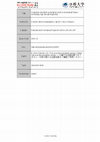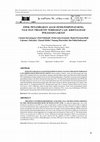Papers by Lisman Suryanegara

Reactive and Functional Polymers, 2014
We report here the morphology and tensile properties of polylactic acid-cellulose nanofibre (PLA-... more We report here the morphology and tensile properties of polylactic acid-cellulose nanofibre (PLA-CNF) microcellular nanocomposites. Two types of CNF were used for the nanocomposite preparation, native and surface acetylated CNF (ac-CNF). Samples were foamed in a mould to enable tensile testing. The effect of the mould use on the foam morphology was first assessed by comparison with free foamed samples. We found that the mould affected the cell growth stage of the foaming process in neat PLA foam while its effect was less important in nanocomposites. Stiffening and strengthening effect of CNF was greatly enhanced by foaming when compared to their solid counterparts. The most notable change in tensile properties was however the large increase in strain at break resulting in the high tensile toughness of microcellular PLA-CNF nancomposites. Strain at break increased up to 7.5 times in neat PLA and up to 31.5 times in the foam containing 3% of CNF. Surface acetylation of CNF significantly affected the properties of foams with 9% of CNF loading: while foams with ac-CNF were stiffer, foams with native CNF exhibited higher strain at break and so higher overall toughness.

Soft Matter, 2012
ABSTRACT In this paper, we investigate the role of cellulose nanofibres (CNFs) in the supercritic... more ABSTRACT In this paper, we investigate the role of cellulose nanofibres (CNFs) in the supercritical foaming process of polylactic acid (PLA). The supercritical foaming process of nanocomposites is determined by the nucleating efficiency of the nanoparticle and rheological properties of the polymer melt. Here, the nucleating efficiency of surface acetylated CNFs was compared with that of native CNFs and different CNF loadings were introduced into the PLA matrix forming more or less stiff networks. We characterized the tensile and shear properties of the nanocomposite melts and studied the surface tension at the nucleating site. It was observed that the introduction of CNFs significantly improved the morphology of PLA foams. Both the amount of CNFs and surface acetylation contributed to the reduction in cell size and increase in cell density. The nucleating effect of the CNF surface was clearly evidenced and revealed to be enhanced by surface acetylation. Improved morphology in nanocomposite foams was therefore explained by the interplay of the nucleating and rheological effects of CNFs during the foaming process. Finally, the potential of CNFs to generate nanoporous structures via supercritical foaming was discussed.
Composites Science and Technology, 2009
... 4], [5], [6] and [7]. Compared to inorganic fillers, the main advantages of lignocellulosics ... more ... 4], [5], [6] and [7]. Compared to inorganic fillers, the main advantages of lignocellulosics are their renewability, low cost, and low density [5]. The thermal and mechanical properties of PLA composites have been investigated using plant and pulp fibers as reinforcement [6] and [7 ...
Cellulose, 2010
Polylactic acid (PLA) in a crystallized state has mechanical properties at high temperatures supe... more Polylactic acid (PLA) in a crystallized state has mechanical properties at high temperatures superior to PLA in an amorphous state. However, a long annealing time is required to fully crystallize PLA. In this study, microfibrillated cellulose (MFC)-reinforced partially crystallized PLA composites were produced, with the goal of reducing the time required to fabricate PLA parts. A series of PLA/MFC composites
The main drawback of semi-crystalline type of polylactic acid (PLA) for industrial application is... more The main drawback of semi-crystalline type of polylactic acid (PLA) for industrial application is the longer injection molding cycles compared with conventional polymers such as polypropylene (PP). We found that the combination of nucleant addition and cellulose nanofiber reinforcement had a synergetic effect to accelerate the injection molding cycle of PLA.
Cellulose, 2011
This study evaluates the effects of nucleants phenylphosphonic acid zinc (PPA-Zn) and talc, mold ... more This study evaluates the effects of nucleants phenylphosphonic acid zinc (PPA-Zn) and talc, mold temperature, and microfibrillated cellulose (MFC) reinforcement in the acceleration of injection molding cycle of polylactic acid (PLA). PLA was dissolved in an organic solvent, mixed with nucleant and MFC, and dried compounds were injection molded into molds at temperatures ranging from 40 °C to 95 °C and holding
Journal of Environmental Health Science and Engineering
Industrial Crops and Products

ACS Omega
We study the structural, electronic, and magnetic properties of the antiferromagnetic-layered oxy... more We study the structural, electronic, and magnetic properties of the antiferromagnetic-layered oxyarsenide (LaO)-MnAs system from the first-principle calculation. The increasing Hubbard energy (U) in the Mn 3d orbital induces the increasing local-symmetry distortions (LSDs) in MnAs 4 and OLa 4 tetrahedra. The LSD in MnAs 4 tetrahedra is possibly promoted by the secondorder Jahn−Teller effect in the Mn 3d orbital. Furthermore, the increasing U also escalates the bandgap (E g) and the magnetic moment of Mn (μ Mn). The value of U = 1 eV is the most appropriate by considering the structural properties. This value leads to E g and μ Mn of 0.834 eV and 4.31 μ B , respectively. The calculated μ Mn is lower than the theoretical value for the high-spin state of Mn 3d (5 μ B) due to the hybridization between Mn 3d and As 4p states. However, d xy states are localized and show the weakest hybridization with valence As 4p states. The Mott-insulating behavior in the system is characterized by the E g transition between the valence and conduction d zx /d zy states. This work shows new physical insights for advanced functional device applications, such as spintronics.
IOP Conference Series: Earth and Environmental Science
IOP Conference Series: Earth and Environmental Science

Jurnal Kimia Sains dan Aplikasi
Polylactic acid (PLA) is a biopolymer that can replace thermoplastic polymers such as polypropyle... more Polylactic acid (PLA) is a biopolymer that can replace thermoplastic polymers such as polypropylene (PP) in various applications due to strength, young modulus, biocompatibility, biodegradability, good clarity, oil resistance, and oxygen barrier ability. However, PLA has some drawbacks, including brittle, high glass transition temperature (Tg), and low degradation and crystallization rates. Therefore, modification is needed with the addition of nucleating agents and plasticizers to overcome these limitations of PLA. This research aims to study the effect of plasticizers and microfibril cellulose of oil palm frond (OPF) on thermal stability and to review the crystallization kinetics of PLA biocomposites. Polyethylene glycol and triacetin were used as plasticizers. Thermal analysis was performed using Thermal Gravimetry analysis (TGA) and Differential Scanning Calorimetry (DSC). The crystallization kinetics study was analyzed using a modified Avrami model under non-isothermal conditio...

Jurnal Sains Materi Indonesia
Dalam aplikasi industri, salah satu kekurangan poli asam laktat (PLA) adalah kristalisasi yang la... more Dalam aplikasi industri, salah satu kekurangan poli asam laktat (PLA) adalah kristalisasi yang lambat, sehingga meneyebabkan waktu yang lebih lama untuk mengolah PLA dibandingkan dengan polimer konvensional seperti polipropilen. Penelitian ini mengevaluasi pengaruh penambahan pengisi atau aditif terhadap laju kristalisasi PLA. PLA dilarutkan dalam diklorometana (DCM) dan dicampur dengan nucleating agent (seng asam fenilfosfonat atau talk) atau pelunak (triasetin) pada konsentrasi yang berbeda diikuti dengan pengeringan pada suhu kamar selama 24 jam dan pengeringan oven selama 2 jam pada suhu 80 °C. Campuran kering PLA ditempa panas pada 180 °C selama 10 menit. Differential Scanning Calorimetry (DSC) dilakukan untuk mengevaluasi tingkat kristalisasi. Hasil studi menunjukkan bahwa penambahan pengisi atau aditif mempercepat proses kristalisasi PLA. Asam seng fenilfosponat (PPA-Zn) adalah pengisi yang paling efektif untuk mempercepat laju kristalisasi PLA.
International Journal of Biological Macromolecules

Jurnal Sains Materi Indonesia
SURFACE MODIFICATION OF TEMPO-MEDIATED CELLULOSE NANOFIBRIL WITH OCTADECYLAMINE. In this study, s... more SURFACE MODIFICATION OF TEMPO-MEDIATED CELLULOSE NANOFIBRIL WITH OCTADECYLAMINE. In this study, surface modification of 2,2,6,6-tetramethylpiperidine-1-oxyl radical TEMPO-cellulose nanofibrils (TCNF) was obtained by 1-ethyl-3-(3-dimethylaminopropyl) carbodiimide hydrochloride (EDC) and N-hydroxysuccinimide (NHS)-mediated system. The carboxylate groups on TCNF surface was replaced by conjugation of octadecylamine (ODA). The conversion of the carboxylate groups on CNF into amide I and II groups was confirmed by attenuated transform reflectance-infrared (ATR-FTIR) and elemental analysis study. Further, decarboxylation of TCNF at higher temperature was hindered by the presence of amide groups resulted in the higher thermal stability of TCNF as observed by thermogravimetry analysis (TGA). These results suggested the possibility of modifying surface negatively charged of TCNF with conjugated amine groups into thermally stable nanocellulose.

The objective of this work is to investigate the influence of ZnO on the thermal behaviour of PLA... more The objective of this work is to investigate the influence of ZnO on the thermal behaviour of PLA/ZnO biocomposite films. A solvent casting method was used to prepare the PLA and the PLA/ZnO biocomposite films. The effect of the ZnO content was tested with PLA/ZnO biocomposite films prepared with different ZnO content, i.e 0.1 and 1 phr, with respect to the neat PLA. Analysis on functional groups of PLA and PLA/ZnO biocomposite films were conducted using Fourier Transform Infrared (FTIR). The thermal behavior properties were measured by Differential scanning calorimetry (DSC) and Thermogravimetric analysis (TGA). The glass transitions temperature of PLA/ZnO biocomposite films showed a significant shift of the glass transition and melting temperature towards lower temperatures. The increasing ZnO content added into PLA/ZnO biocomposite films decreased the glass transition and melting temperature. The addition of ZnO into PLA matrix accelerated thermal degradation of PLA/ZnO biocomposite films. The increase of ZnO content in PLA/ZnO biocomposite films increased the char residue.
Sustainable Humanosphere Bulletin of Research Institute For Sustainable Humanosphere Kyoto University, Sep 1, 2008
Proceedings of the 2014 International Conference on Physics and its Applications, 2015








Uploads
Papers by Lisman Suryanegara